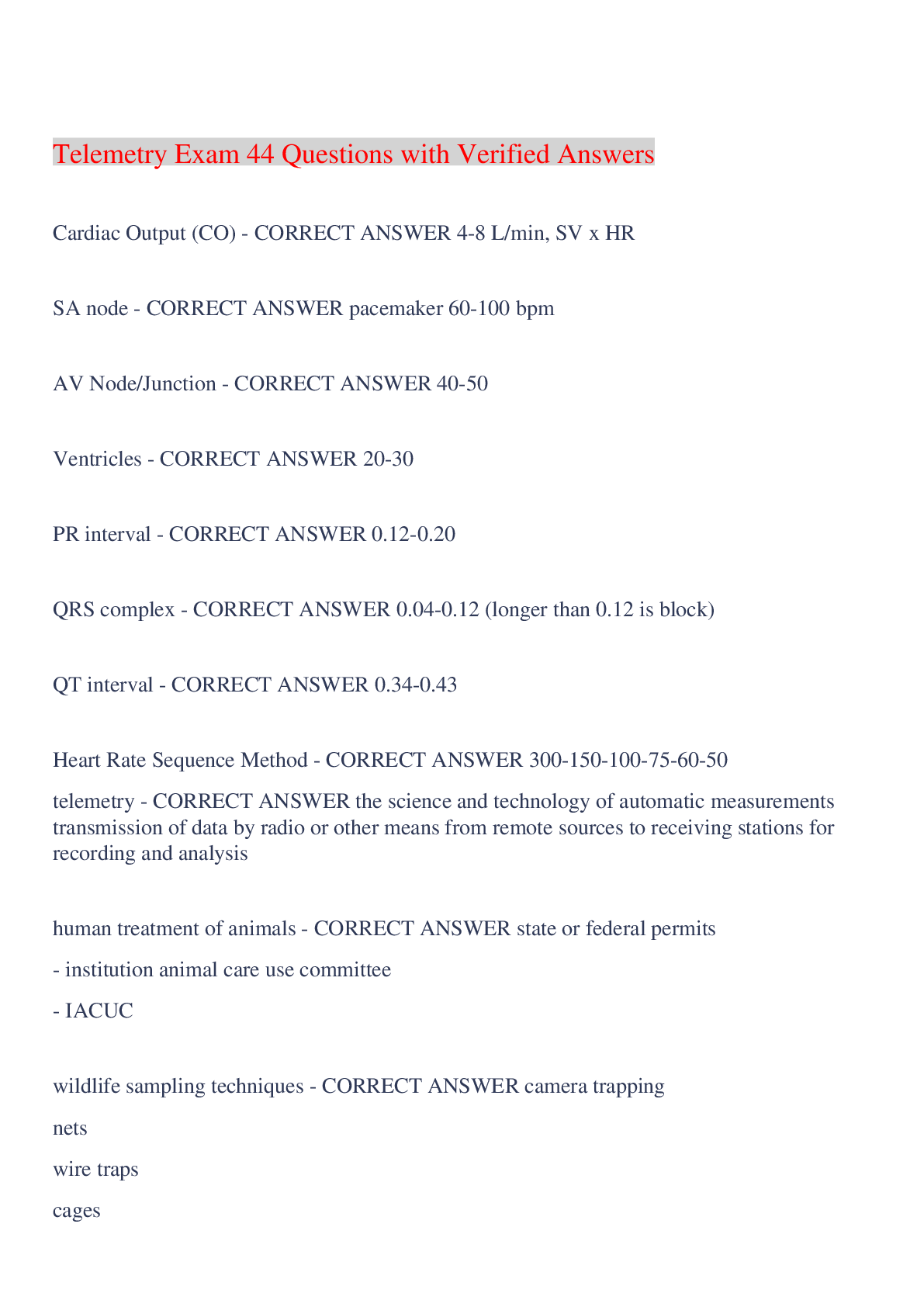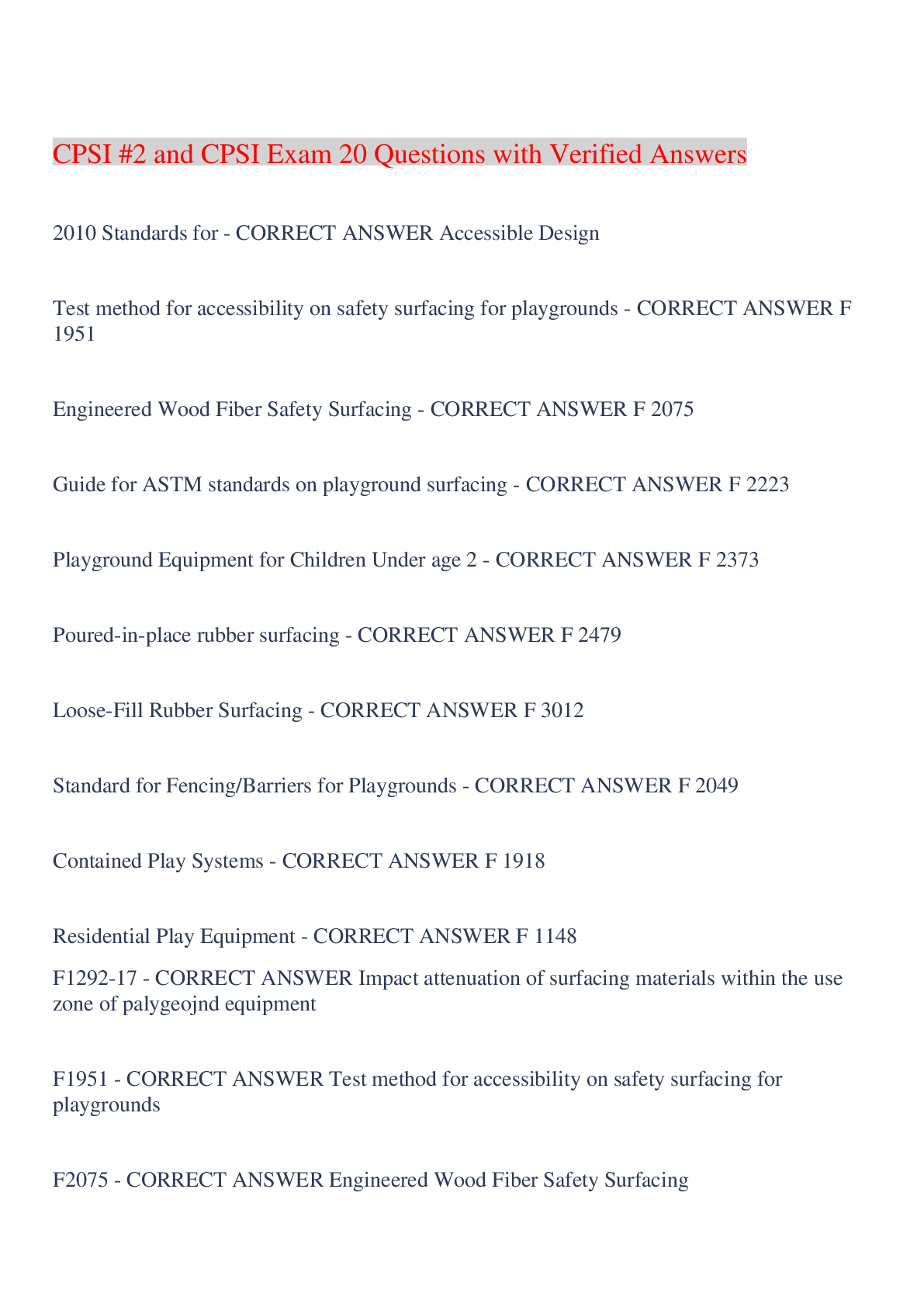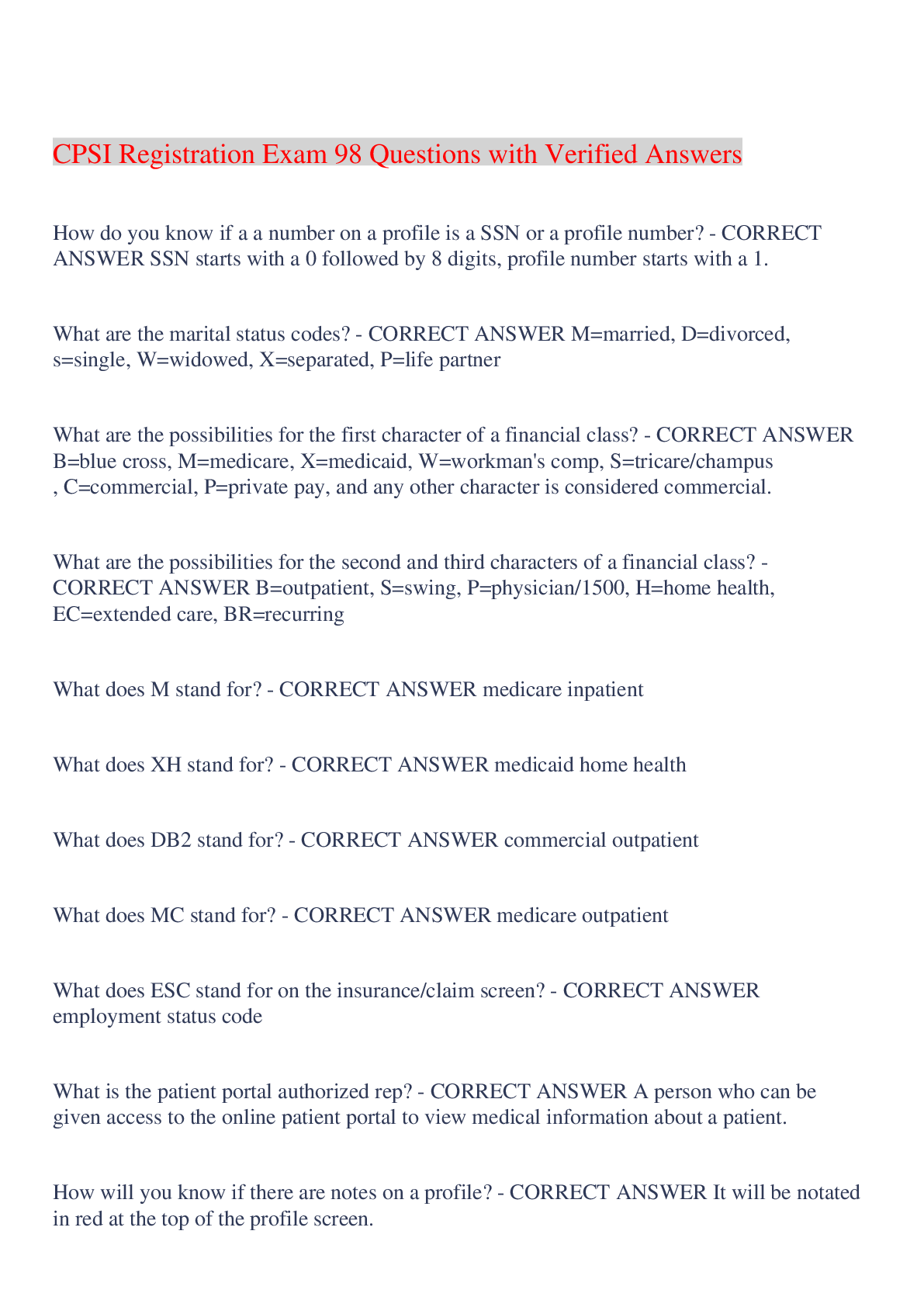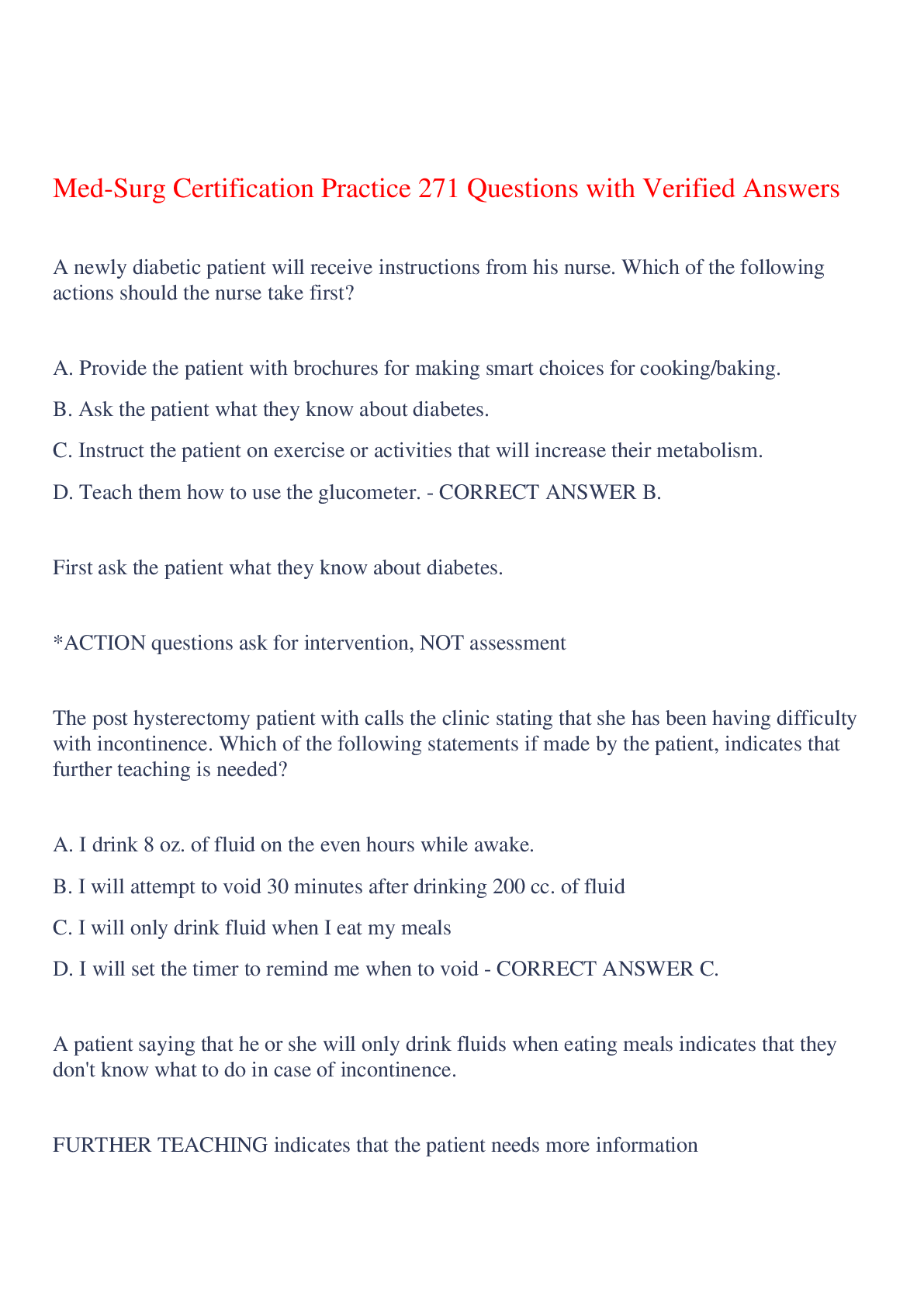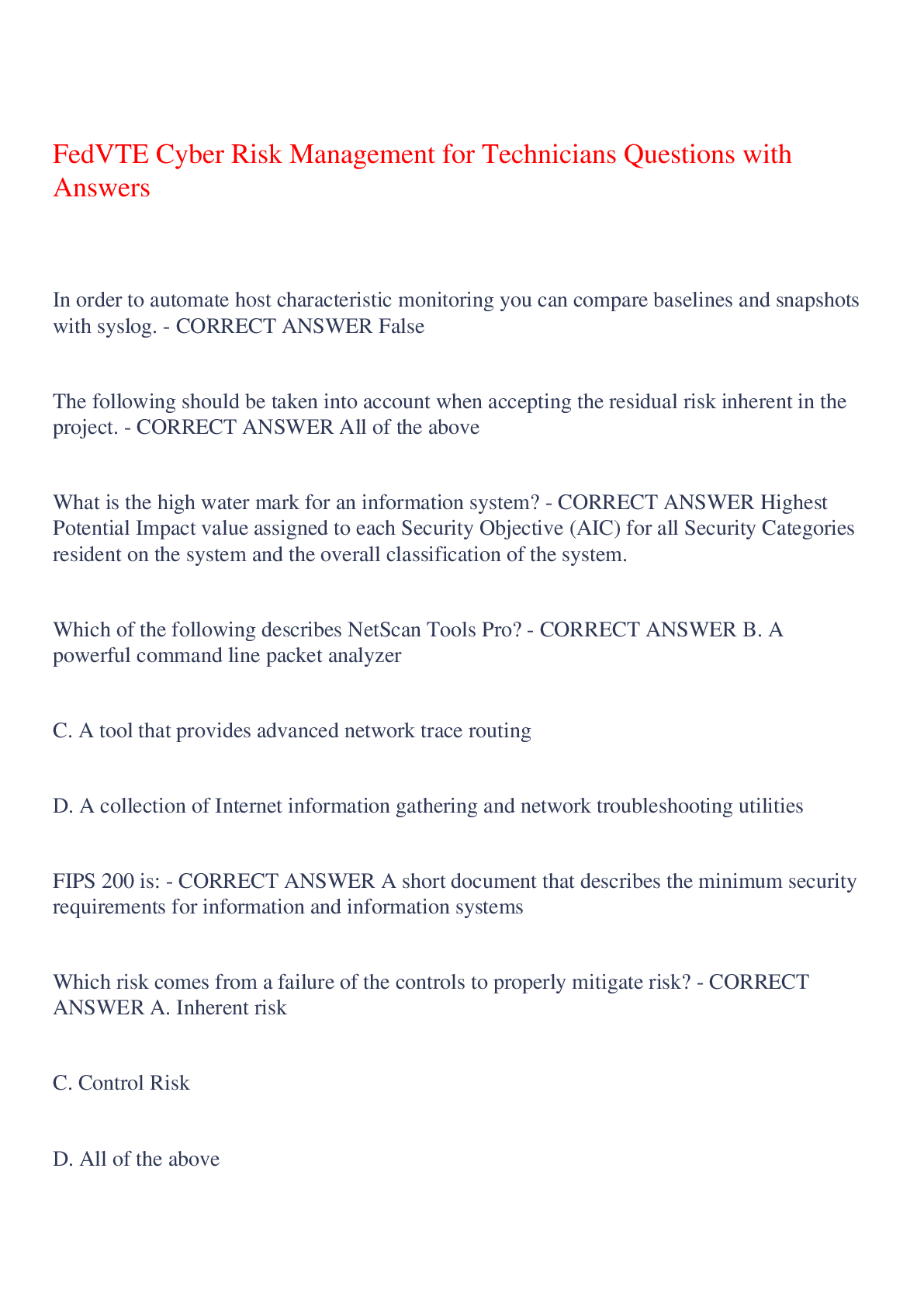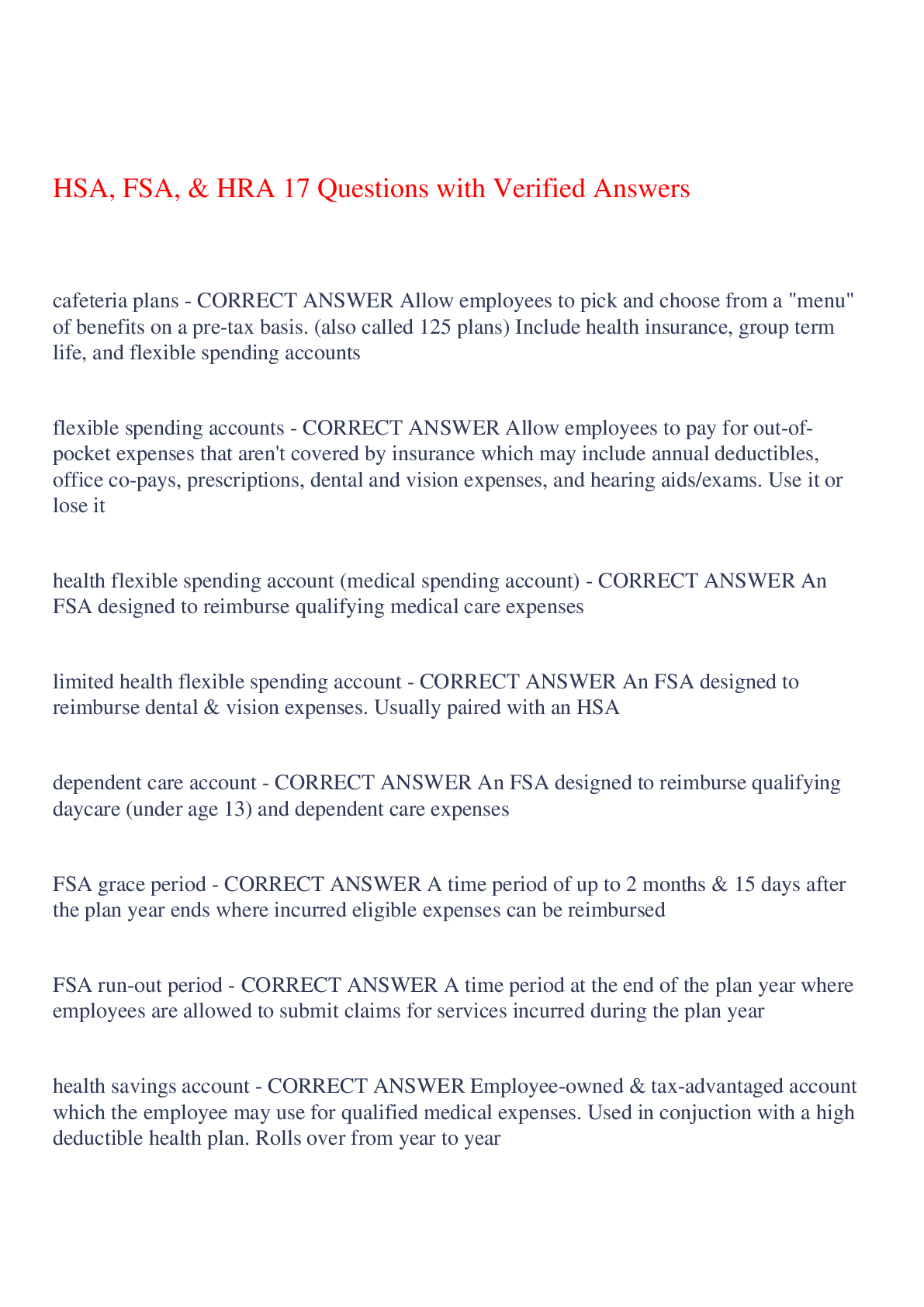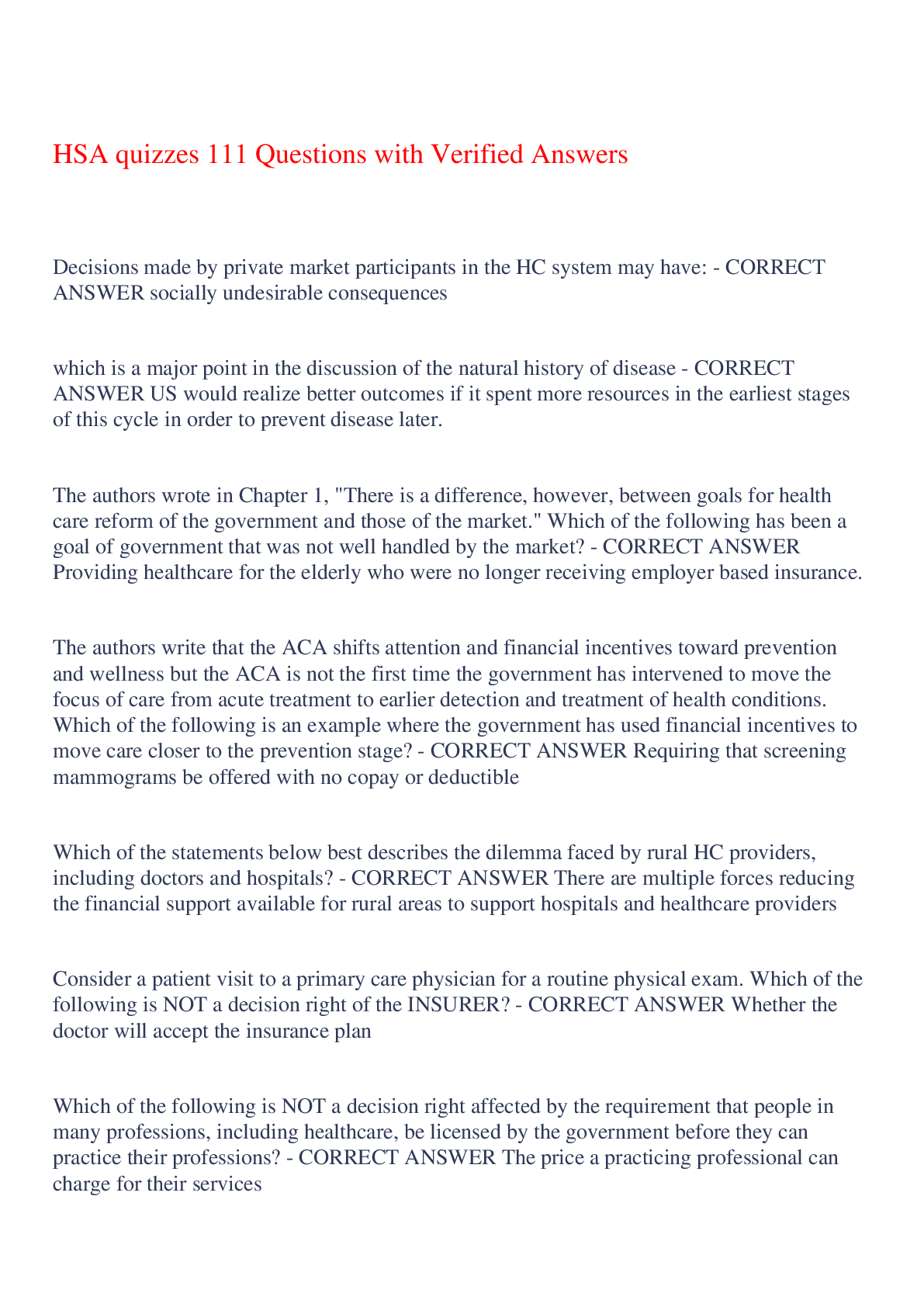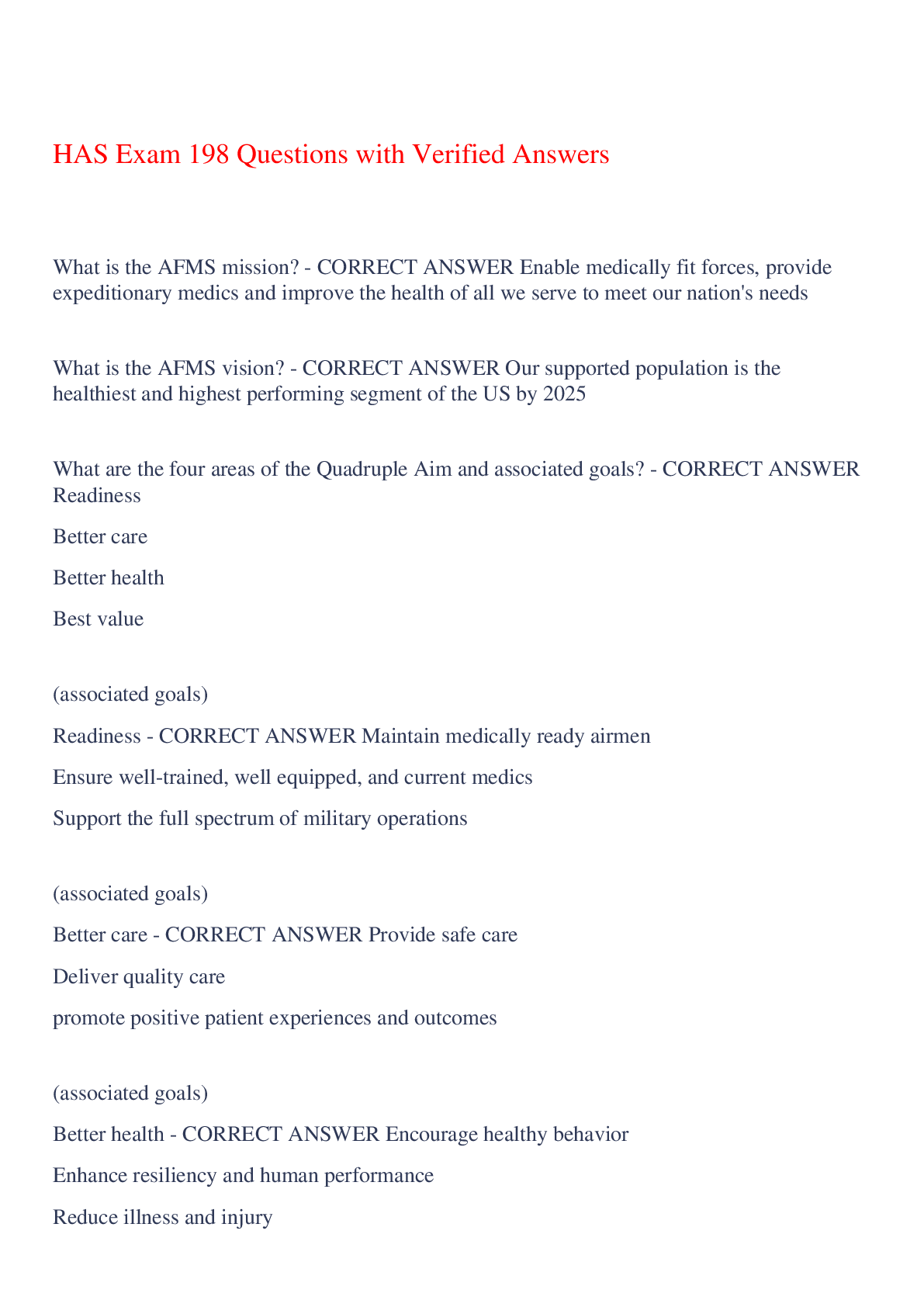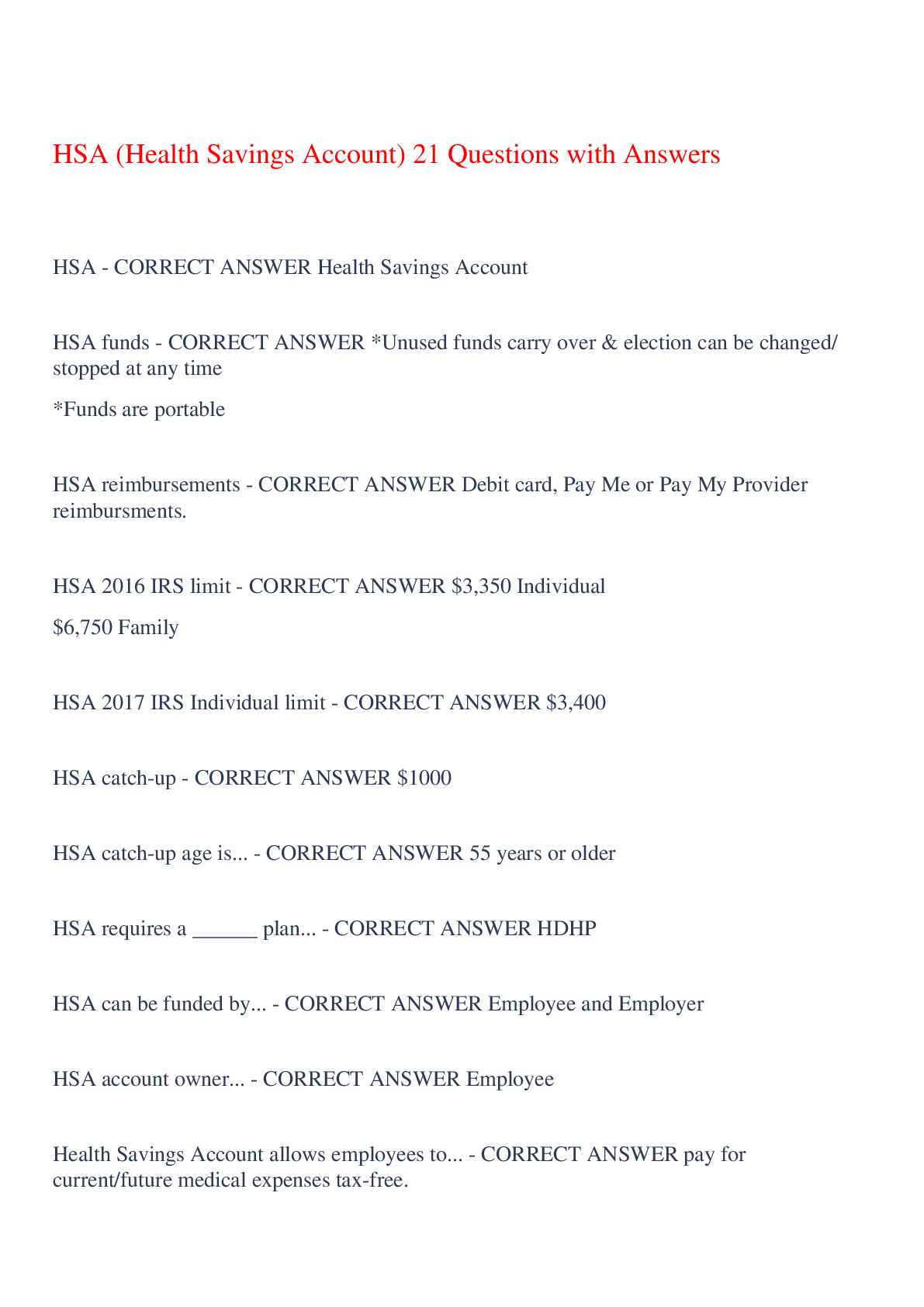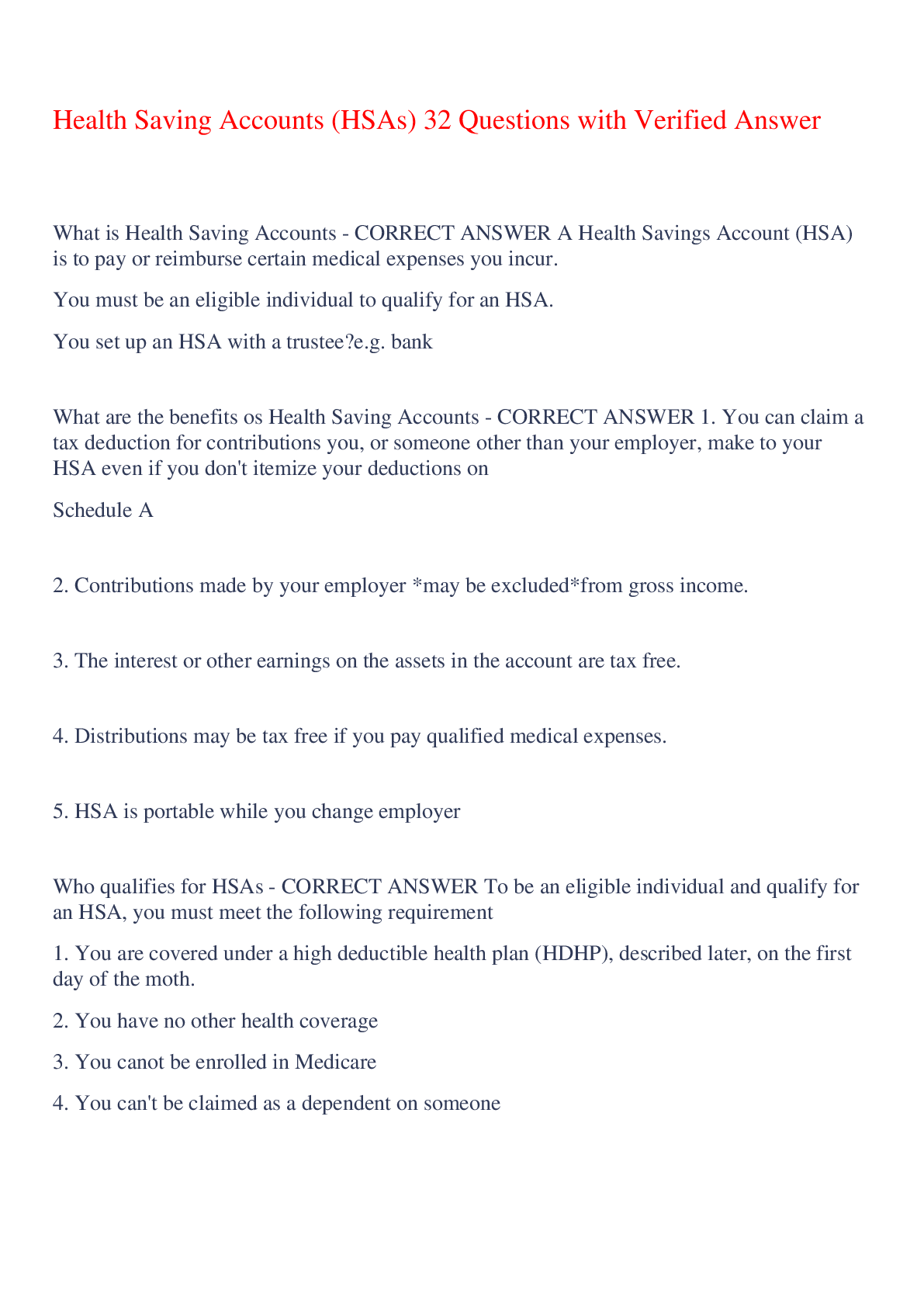NUR2502 Multidimensional Care III Final Exam Outline MDC IV,100% CORRECT
Document Content and Description Below
NUR2502 Multidimensional Care III Final Exam Outline MDC IV • Autonomic Dysreflexia: S/S: Sudden rise in BP with Bradycardia. Profuse sweating above Injury. flushing of skin. Blurred/Spots in... vision. Nasal congestion Causes: Urine Retention! Sympathetic Nervous System is Stimulated = Patient Goes into Overdrive Straight Cath Bladder Distention/UTI Constipation Pain, Temp Fluxuations GI, GU Vascular Stimulation Interventions: AD is neurologic emergency & must Be Promptly treated to prevent Hypertensive Stroke! If pt experiences AD, raise head of bed immediately to help reduce BP. Place pt in a sitting position (First Priority!), or return to previous safe position. Check for urinary retention or Catheter Blockage: Check urinary catheter tubing (if Present) for Kinks or Obstruction. 1. If Urinary Catheter is not present, check for Bladder Distention & Catheterize immediately if indicated: 2. Consider using anesthetic ointment on tip of catheter before catheter insertion to ↓ urethral irritation. Determine if Urinary tract infection or Bladder Calculi (Stones) are contributing to genitourinary irritation. Check pt for Fecal Impaction or other colorectal irritation, Using Anesthetic Ointment at rectum. Disimpact if needed. Examine skin for new or worsening pressure injury s/s. Monitor BP q 10-15 Min. Give Nifedipine or Nitrate to Lower BP. Paralytic Ileus may develop within 72 hrs of Hospital Admission. • ARDS: ↑ Alveolar Permeability + Leaking of Fluid = Alveolar Collapse ARDS Causes: Systemic inflammatory response, more Edema, Surfactant going down after lung injury or illness Intubated & Sedated, Antibiotics, Fluids Sepsis. Burns. Pancreatitis. Transfusion. Trauma. Diffuse Pulmonary Infection - Gastric Aspiration. O2 Toxicity. Lung Contusion ARDS S/S: Persistent Hypoxia (Even w/ O2 Therapy). Dyspnea. ↓ Pulmonary Compliance. Non-Cardiac Pulmonary Edema ARDS Diagnosis: Refractory Hypoxia Chest X Ray Shows Glossy + White out (Diffuse Patchy Infiltrates) Normal Wedge Pressure - pO2/FIO2 < 200 ARDS Phases: Injury (Exudative) Phase = Alveolar Collapse. Early changes of dyspnea & tachycardia. Alveoli fluid filled, pulmonary shunting, Atelectasis. Provide O2 Refractory = Hypoxemia Reparative (Proliferative) Phase = Decreased Lung Compliance Fibrotic Phase = Surfactant Cells Are Damaged ARDS Treatment: Intubation/mechanical ventilation (PEEP high - monitor for tension pneumothorax) Treatment options do not reverse or treat the lung damage that has occurred. Treatment is centered around preventing further lung damage and treating underlying cause such as sepsis. Positioning: prone to promote lung drainage. ↑nutrition to prevent difficulties weaning from vent • Assessing in emergencies • Activation of HICS • Bee sting: 1st aid for bee sting treatment-remove stinger-ice or cool water compress- antihistamine (oral or topical) Epi, then O2 • Burns: Management 1st hour is critical. Airway & breathing is top priority, then circulation. Next is limiting extent of injury & maintaining function of vital organs. Resuscitation Phase Resuscitation phase is 1st intervention that takes place with victim. begins at time of injury & can last up to 48 hrs. Focus is on: Fluid imbalance (loss). Edema. Blood flow (perfusion). Priorities: Airway. Provide oxygen therapy. Evaluate for direct airway injury that occurs by inhalation of smoke, heat, or chemicals. Ask about: Source; Duration of exposure; Was fire in enclosed space? If hair is singed off, or skin is burned further, assess inside of mouth for Debris; evaluate inhalation injury by soot around nose pt may become progressively hoarse/may drool or have difficulty breathing; Listen for wheezing, stridor, crowing BE ALERT FOR THESE AS IT INDICATES THAT THE CLIENT IS ABOUT TO LOSE THEIR AIRWAY. Support circulation & organ perfusion = accomplished by fluid replacement Be alert for s/s of pulmonary edema; Be cautious with diuretics to ↑UO. Rather, adjust fluids to ↑ UO. Electrical burns can cause damage to muscles which can release myoglobulin into bood which can cause acute renal failure. Pain management Prevent infection = wound care Maintain body temp Labs: Hemoglobin/Hematocrit Blood urea nitrogen Glucose Electrolyte panel ABGs Meds prophylaxis in burn pts: mafenide acetate, silver sulfadiazine, silver nitrate solution, silver-impregnated dressings Opioids- morphine, hydromorphone Nonopioids – paracetamol, dipyrone, selective cyclooxygenase 2 inhibitors [COX 2 enzyme responsible for pain & inflammation], for neuropathic pain gabapentin or pregabalin Asepsis. Early detection. Minimize weight loss. Promote positive Self- image -grieving process Kubler ross. Maintain mobility. Positioning. ROM. Ambulate. Wear pressure garments 23 of 24 hrs-educate importance. electrolyte imbalances asoc w/ burns: Acid-base imbalances: Hypovolemia (high mortality rate) Metabolic acidosis. Hyperkalemia. Hyponatremia. Hemoconcentration (↑ blood osmolality=↑blood viscosity = tissue hypoxia) if burn is 25% or greater of total body surface area (TBSA) burned that within 1st 12 hrs there will be a lot of swelling as fluid shifts into interstitial space. fluid shift will cause weight gain & edema. Pt is at risk for Hypovolemic shock, → leads to MOD & death. Respiratory complications: Emergency Management of Burns: Assess for airway patency. Admin O2. Cover pt with blanket. Keep pt on NPO status. Elevate extremities if no fractures are obvious. VS. Initiate IV line; begin fluid replacement. Admin Tetanus toxoid for prophylaxis. Perform head-to-toe assessment. Smoke Inhalation: S/S- Face or neck burns. Singed nasal hairs. Soot in upper airway. Airway! Internal damage- Assess Sputum If pt has burns w/ brassy cough, soot around mouth/nose →Inhalation Injury Inhalation injury Interventions: ABC. 100% Humidified O2. Monitor VS, LOC, Oxygen, Saturation, Cardiac Rhythm. Monitor BS. Establish IV Access w/ 2 Large bore catheters if burn > 15% TBSA • Carbon monoxide poisoning: What VS do you see w/ CO Poisoning? Normal O2 Sat S/S: CHERRY RED colored skin. Headache. Confusion Treatments: Non-Rebreather Mask. 100% O2. Hyperbaric Chamber. if on face & neck→ intubate. Monitor carboxyhemoglobin levels → abnormal >15%. Thermal injury. Smoke poisoning. Pulmonary fluid overload. External factors. Facial edema Critical Rescue Monitor pt's respiratory efforts closely to recognize possible airway involvement. For burn pt in resuscitation phase who is hoarse, has brassy cough, drools or has difficulty swallowing, or produces audible breath sound on exhalation, respond by immediately applying oxygen & notifying RRT Infection: tetanus shot 5 to 10 y. Protective isolation: wear hair cover, shoe cover, gown, gloves, mask. Use sterile linens and gowns. Sterile gloves for dressing changes. Strict hand hygiene. Room Temp: 85-100*F Educate: GO OUTSID • CSF leaking- testing for: If pt has skull fracture w/ clear drainage coming from nose/ears, surgical Site…. What should you do? Test Drainage for + Glucose, Halo Test (Ring Around Paper) • CVA Care: • Delegation • Drowning: Cause: Drowning. Alveolar collapse. ARDS. Oxygenate, Gastric Decompression, Ask: TEMP OF WATER. DURATION & SEVERITY, How Long Were They Without Oxygen? physical effects: possible complications: • DOPE (Know alarms assoc w findings) • EEG education: • ED: staff & client safety principles • Fire (Code Red) • RACE protocol for Fires • PASS • Frostbite: Body tissue freezes, like burn can be superficial partial or full thickness. Frostbite Degrees: 1st: Hyperemia, Edema 2nd: Clear to Milky Fluid Filled Blisters with Partial Thickness Skin Necrosis 3rd: Small Blisters with Dark Fluid, Affected Body Part Cool, Numb, Blue or Red, Does Not Blanch 4th: no Blisters or Edema, Cold, Bloodless Gangrene Can Develop. Treatment: Stop exposure to cold! Body heat to rewarm prehospital/ hospital Rapid rewarm in water bath. Opiod Analgesics: Ibuprofen for Inflammatory Cascade Elevate above heart after rewarming Debridement of tissue in higher degree frostbite. Frostnip: Superficial cold injury pain, numbness, waxy no tissue damage • GBS: Acute inflammation of axons or myelin of PNS Cause: Infection. Vaccine. Autoimmunec. S/S: Parethsesias. Muscle weakness. Loss of reflexes in arms/legs. Low BP/ poor BP control. Muscle weakness without muscle atrophy. Uncoordinated movements. Blurred vision. Palpations. ↓ Respiratory function. Diagnosis: CSF-↑ Protein, Lymphocytes Normal. EMG-normal early changes after 4 weeks. CT/MRI rule oute. Interventions: Plasmapheresis. IVIG. IV immunoglobulin therapy & plasma exchange Risk for: newborns, older adults, Diabetes. Heart disease. Congestive heart failure. Cancer or history of cancer. Obesity • Homonymous hemianopsia: • Halo device teaching (not pin care) • Heparin • HAZMAT • Heatstroke Temp Over 104* (Emergency) S/S: Exertional. Elderly & Children in Hot House. Body Temp Over 104 Hot Dry Skin. Mental Status Changes: Confusion, Anxiety, Agitation, Seizures, Coma. Hypotension; Tachycardia; Tachypnea; Electrolyte Imbalance; ↓ Renal Function; Abnormal Clotting; Crackles. Treatment: Pre-Hospital: Cool Patient Down, Remove Clothing Cold Water on Body, Fan. Ice Packs Hospital: Actual emergency! Super high temp IV Fluids O2, Intubation PRN, electrolytes. Stop shivering (↑ Body Temp). Multisystem Organ Failure Large Bore IV. NS (Cooled preferably). Cooling Blanket. Rectal Temp Q15 Indwelling Urinary Cath. Frequent Vitals Labs-Electrolytes, Cardiac Enzymes, Liver Enzymes, Stop Shivering Stop cooling when body is at 102 Risk factors (know how to prevent-teaching) Prevention of complications during treatment • Heat exhaustion: Mild S/S: Shivering; Dysarthria (Slurred Speech); Diuresis. Moderate S/S: Muscle Weakness; ↑ Un-Coordination; Confusion; Apathy; Incoherence; ↓ Clotting Severe S/S: Bradycardia; Hypotension; ↓ RR; Cardiac Dysrhythmia; ↓Neurologic Reflexes; ↓ Pain Response; Acid-Base Imbalance. Is continued ↓ in core body temp after victim is removed from cold environment After-Drop (Warm people too fast) Treatment: Prevent heat loss Warm up. No alcohol. Dry clothes & dry blankets – Remove. Supine. Space out Meds. Withhold IV meds until core Temp 86 or Higher. Monitor for V-Fib. Rewarm trunk. Heat Exhaustion Interventions: Rest in cool place. Cold pack on neck, Ab, groin soak in cool water rehydrates w/ electrolytes Heat Exhaustion S/S: Flu-Like Headache. Heavy Sweating Risk factors (know how to prevent-teaching)???? Prevention of complications during treatment???? • Hypothermia: Mild S/S: Shivering. Dysarthria (Slurred Speech). Diuresis. Moderate S/S: Muscle weakness. ↑un-coordination. Confusion. Apathy Incoherence. ↓ Clotting Severe S/S: Bradycardia. Hypotension. ↓ RR. Cardiac Dysrhythmia. ↓ neurologic reflexes. ↓ Pain response. Acid-Base imbalance is continued ↓ in core body temp after victim is removed from cold environment: After-Drop (warm people too fast) Interventions: Prevent heat loss warm up. no alcohol. Dry clothes & dry blankets – remove. Supine. Space out meds. Withhold IV meds until core temp 86 or higher. monitor for V-Fib. Rewarm trunk prevention of complications Warm body core first, NOT extremities. Warming extremities first can cause shock. It can also drive cold blood toward heart & lead to heart failure. • Informed consent • Internal vs external disaster • ICP: S/S: ↓ LOC. Restlessness, Irritability & Confusion. Headache. N/V. Change in speech. Pupillary changes. Ataxia. Seizures. Cushing Triad. Posturing Reduction Prevention ↓ LOC; Restlessness, Irritability & Confusion; Headache; N/V; Change in Speech; Pupillary Changes; Ataxia; Seizures; Cushing Triad; Posturing. Interventions: HOB elevate: at Least 30* or More = Postural Drainage; O2 Over 94%; Head neutral position; No sudden movements; No cluster of cares; Low stimulation. • Fire response • Fractured Rib / Flail chest: Life-threatening medical condition that occurs when segment of rib cage breaks due to trauma & becomes detached from rest of chest wall; Flail Chest; 2+ Ribs; Flail Chest Stabilized by: Positive Pressure Ventilation Rib Fracture: Reduce pain so they will breathe - risk for pneumonia Not coughing to clear Airway, no Deep Breaths. S/S: Paradoxical Chest Movement; Dyspnea; Cyanosis; Tachycardia; Hypotension. Pt Presentation: Anxious; SOB; In pain. Interventions: Humidified Oxygen; Pain Management; Promotion of Lung Expansion through Deep Breathing & Positioning; Secretion Clearance by Coughing & Tracheal Suction. Mechanical Ventilation: Respiratory Failure; Shock; Severe Hypoxemia & Hypercarbia. Nursing Care: Monitor ABG & VS • Latex allergies • Meningitis • Mass Casualty (know definition) Colors/description/Clients Evacuation Protocol, principles for discharging clients • MG crisis Prevention • MS: Meds: • MAP • Maslow’s: Nursing Diagnosis (follow M.): • Med reserve corps vs • DMAT (Disaster Medical assistance team) • Medical emergency (Code Blue) • Medical Reserve Corps (MRC) • Nurse readiness • Parkinson’s: Meds: • Parklands: 4ml x BSA (%) x weight (kg): half give for 1st 8hrs, Other half for next 16 hrs. • Primary survey • Personal preparedness for a disaster: Pet Care, Child Care, Hurricane Teams, “Ready to Go” • ASD & • PTSD: prevention, clinical manifestations, critical incident stress debriefing (CISD) • Posturing (decerebrate, decorticate, flaccid paralysis) • Post op pt: Assessment Education Lab values Prevent Complications: Blood Clots, Pneumonia, Infection. ABC. Altered LOC: Agitation. O2 Sats. HR. BP Why Is a Drain Needed Post-Operatively? Prevents fluid buildup, fluid ↑ risk of infection • Pneumothorax Risk for:????? Tension Pneumo Emergency, Entire Lung Has Collapsed. Pneumothorax S/S: Diminished breath sounds on affected side: distended neck veins. Pneumothorax Interventions: Mild & stable - may or may not need tx, Chest tube Tension Pneumo: Deviated trachea if tension puff toward good side No Breath Sounds Needle thoracostomy immediate if tension 14g large needle First Goal: Reinflate Lung Needle Decompression, Thoracostomy Immediate if Tension 14g Large Needle; Pain Control; Pulmonary Hygiene • Pulmonary Embolism: Immobile, bedbound, long flight, recent surgery, hx of PE, Smoking + Oral contraceptives, clotting disorder. Caused by Long Bone Fracture. Heparin Drip. IVC filter before surgery if pt has Hx. CT scan, (CT Angio) D-Dimer, VQ Scan, Doppler (if arms or legs). S/S: Sudden Dyspnea; Sharp stabbing chest pain; Anxiety; Chest Pain; Cyanotic; Cough; Tachypnea; Crackles; Pleural Friction Rub. S3 or S4 Sounds; Diaphoresis; Fever; ↓ SaO2. Interventions: RRT; ↑ HOB; O2; ABG's Assess Respiratory / Cardiac Status; Imaging; Anticoagulation; IV Fluids; Hypotension - Norepi, Dobutamine, Nitroprusside. Surgery: Embolectomy-Removal of Embolis; IVC Filter- short term fix to block embolism from reaching lungs • Rule of nines: Head = 9% • Arms = 18% (9% Each) • Back = 18% • Front/Chest 18% • Legs 36% (18% Each) • Genitalia = 1% • Sepsis: Sepsis protocol: Labs in sepsis Prevention teaching Assessing for • Shock Hypovolemic: Caused by: Blood Loss = Low Blood Volume Dehydrated (Adults and Kids) Poor Clotting = Pts will keep bleeding Cariogenic Shock Cause by: Unhealthy heart (MI pt) Distributive Shock Neurogenic and Chemical Neurogenic: Relaxing blood vessels (Vasodilation) ↓CO2. Brady, Hypotensive, Weakness, Chest Pain Flaccid Paralysis. Pressors (Levo) & Atropine for Heart Rate! Chemical: Anaphylaxis: Epi w/ swelling of lips, throat Steroids, Benadryl Septic Shock Obstructive Shock: Cardiac Tamponade: Heart is unable to disperse blood to rest of body. Stages of Shock: Initial: HR ↑, MAP ↓ by 10-15 Nonprogressive: LOW OR NO URINE, Shunting blood didn’t work, THIRSTY Progressive: Rapid Weak Pulse (Doppler) MAP Decreased by 20, Vital Organs are hypoxic, Impending doom, Confused, ↑Potassium & Lactic Acid Refractory: Nonpalpable pulse, Dusky extremities, pt is cold, no perfusion First Goal: OXYGEN (Not Perfusion) Fluids Type of Shock Description Cause Treatment Anaphylactic shock Massive vasodilation caused by release of histamines in response to allergic reaction IV contrast, drugs (ASA, insect bites/stings, anesthetic agents, vaccines, foods, materials (latex) Medication: (histamine H2blockers (Tagament ®), Epinephrine (drug of choice), diphenhydramine (Benedryl®), Volume expander, vasopressor (Dopamine®, Levophed®), Solu- medrol ®, nebulized bronchodilators Ensure pt airway, put pt in recumbent & elevated legs, keep warm Hypovolemic shock Loss of intravascular volume 3rd spacing, diuresis, hemorrhage (#1 cause), burns, GI fluid loss (V/D, drainage from NG tube), DIC,DKA, HHNK, long bone fx Rapid volume replacement (blood, isotonic solutions), Neo-synethrine, control bleeding Cardiogenic Shock Inability of heart to pump blood out effectively pump failure), resulting in ↓ CO Left ventricular dysfunction, MI (most common cause), CABG, arrhythmias, cardiomyopathy, tension pneumothorax, PE, cardiac tamponade Medication: Dobutamine®, Dopamine®, Epinephrine®, Levophed®, Primacor®, Nitroglycerin®, Nipride, Morphine®, intraaoritc balloon pump (IABP), correct arrythmias Septic Shock Sepsis with hypotension despite adequate fluid replacement, massive vasodilation caused by inflammatory response of body due to overwhelming infection Infection (UTI, respiratory tract, indwelling lines (IV, central lines) or catheters), gram-negative bacteria (most common cause) Antimicrobial therapy, surgical drains, volume replacement, cultures, antibiotics, control temperature Neurogenic Shock Pooling of blood-↓ venous return, ↓ CO, hypotension, bradycardia Massive vasodilation due to loss of vascular tone due to suppression of Treat the cause, Dopamine®, Levophed®, Neo- Synephrine® sympathetic nervous system, injury/disease to spinal cord at or above T6, spinal anesthesia, head injury Spinal Shock?? • Seizure Sudden uncontrolled electrical discharge of neurons; Epilepsy = 2 or more seizures Generalized Types: Tonic-Clonic; Tonic; Clonic; Myoclonic; Atonic Partial Types: Complex/Automatisms; Simple. Generalized Seizures: Tonic-Clonic Seizure (Grand Mal): Begins on both sides of brain, but can start in 1 side & spread to whole brain. LOC. Muscles stiffen & Jerking movements. Last 1-3 min & take longer for person to recover. Tonic Seizure: Sudden stiffness or tension in muscles of arms, legs or trunk. Stiffness lasts 20 sec & most likely to happen during sleep. If occur while pt is standing may cause to fall. After seizure, pt may feel tired or confused. Clonic Seizures: Repeated jerking movements of arms legs on 1 or both sides of body. Sometimes w/ numbness or tingling. If it’s focal (Partial) seizure, pt may be aware of what's happening. During generalized seizure, pt may be unconscious. Myoclonic Seizures: Brief shock-like jerks of muscle or group of muscle They occur in variety of epilepsy syndromes that have different characteristics. Pt is awake & able to think clearly. Atonic: Muscles suddenly become limp. Part or all of body become Lime. Partial Seizures: Complex/Automatism Seizure: No purposeful, stereotyped, & repetitive behaviors that commonly accompany focal impaired awareness seizures (in Semiologic Classification, they define auto motor seizures). Behavior is inappropriate for situation. Pts are usually amnestic to their automatisms. Simple Seizure Simple partial seizure will affect only 1 area of brain. It doesn't cause you to lose consciousness Causes of Seizures Primary: Idiopathic. Genetic factors Causes of Seizures Secondary: Tumor or trauma. Metabolic disorders. Acute alcohol withdrawal. Electrolyte imbalance. Fever. Stroke. TBI. Substances. Heart disease. Seizure Diagnostic Testing: CT/MRI. SPECT/PET. Metabolic Labs. EEG Pt Education for EEG Stay Still, no Caffeine, Eat Breakfast (don't want to develop hypoglycemia) Meds: Dilantin: Seizure Interventions Meds Preventative?????? • Phenytoin (Dilantin, Phenytek) (Most Widely Used) Can’t stop abruptly IV Form if Patient Is Vomiting 10-20 Blood Level • Fosphenytoin (Cerbryx) • Carbamazepine (Tegretol, Tegretol XR, Tegretol-CR Image, Carbatrol) • Oxcarbazepine (Oxtellar, Trileptal) • Lamotrigine (Lamictal) • Valproic Acid (Depakote, Depakoke ER, Epival Image) • Primidone (Mysoline) • Gabapentin (Neurontin) • Pregabalin (Lyrica) • Levetiracetam (Keppra) • Topiramate (Topamax) • Ezogabine (Potiga) (1st approved Potassium Channel opener drug Approved for adjunctive management of Partial-Onset Seizures) Seizure Interventions Prevent Injury Bring to floor. Roll on side. Clear objects. Away observe & document. Loosen clothing if restrictive. Oral suction in mouth PRN Status Epilepticus: Seizure lasting longer than 5 min or repeated seizures over 30 Min. Med emergency. Give Benzodiazepine "Pam". IV Phenytoin Interventions: Vagal nerve stimulation-prevents seizures by sending regular, Mild pulses of electrical energy to brain via vagus Nerve. "Pacemaker for brain." Stimulator device is implanted under skin in chest. Wire from device is wound around vagus nerve in Neck. Brain resection/corpus callosotomy-palliative surgical procedure for treatment of medically refractory epilepsy. In this procedure Corpus Callosum is Cut through in effort to limit spread of Epileptic activity between 2 halves of Brain. Seizure Phases Prodromal Some people can tell when seizure is on its way Mood changes, anxiety, feeling lightheaded, behavior changes. Difficulty sleeping, difficulty staying focused Aural Ictal Time from 1st s/s to end of seizure activity Loss of awareness. Memory lapse. Felling confused. Difficulty hearing Difficulty speaking or saying strange words. Twitching. Loss of muscle control. Repeated movements (lip smacking or chewing). Body convulsions. Racing Heart. Trouble Breathing. Postictal Occurs after active part of seizure = Recovery Stage Physical after effects of seizure are felt s/s: Confusion/ Lack of consciousness. Tiredness (Fatigue). Headache. Loss of Bladder or Bowel Control. Fear & anxiety/ frustration. Nausea. Sore muscles, weakness in parts of body. Injury (Head, Cuts, Broken Bones) • Staff care post incident: • Stroke Thrombotic stroke, assessment, care of Ischemic stroke- Treatment • Surgical drains & tubes: Surgical Site Infection: Temp, Wbc, Red, Warm, Swollen, Drainage, Pain Post Op Care: Prevent Complications: Blood clots, pneumonia, infection. ABC. Altered LOC: Agitation. O2 Sats. HR. BP. Why Is a Drain Needed Post-Operatively? Prevents fluid buildup, fluid ↑ the risk of infection Surgical positioning for comfort • Triage: Triage Rules: Decide who gets room, when. Highest acuity gets room 1st. No One gets sent home. Triage Emergent: Life Threatening: 1. Respiratory Distress 2. Chest Pain with Sweating 3. Stroke 4. Active Hemorrhage 5. Unstable VS. Triage Urgent: Needs quick treatment, but not immediately life threatening Severe Ab Pain. Renal Colic. Complex or Multiple Bruises Displace or Multiple Fractures. New Onset Respiratory Infection (Pneumonia) Triage Non-Urgent: Could wait several hours & Survive 1.Rash. 2.Strains & Sprains. 3.Colds. 4.Simple Fractures. Mass Casualty Triage Tags Green- Nonurgent Fracture/ Sprain Yellow- Urgent Within the Hour Red- Emergent Hemorrhage, 911 Emergency Black- Ignore (Probably Going to Die) (know definition) o Primary Survey – ABCDE o Secondary Survey • Tagging • Vented pt Care pH 7.35 – 7.45 mmol/L Pa02 80 – 100 mm Hg PaCO2 35-45 mm Hg HCO3 22-26 mEq/L SaO2 ➢ 95% D-dimer 0.5 mg/l of blood or 500 ng/ml of blood WBC 5,000-10,000 cells/mcl Hemoglobi n (Hgb) Men 14-18 g/100 ml, Women 12-16 g/100 mL Hematocrit (Hct) Men 42-52%, Women 37-47% Sodium 136-145 mEq/L Potassium 3.5-5 mEq/L Dosage and Calculation – (Know how to work these calculations.) 1. A medication order for a client that weighs 90 kg states, infuse dobutamine 250 mg IV in 250 mL D5W at 3 mcg/kg/min. The infusion pump must be set to mL/hr? (Record answer as a whole number. Do not use a trailing zero.) 2. A medication order states, infuse 0.9% normal saline (NS) solution 1000 mL IV over 8 hours. The drop factor of the manual IV tubing available is 20 gtt/mL. The nurse should set the flow rate to deliver how many gtt/min? (Round answer to the nearest whole number. Do not use a trailing zero.) 3. A medication order states, lactated Ringers 1000 mL IV to infuse over the next 9 hours. What is the infusion rate in mL/hr? (Record answer as a whole number. Do not use a trailing zero.) Answers: 1. 16 2. 42 3. 111 [Show More]
Last updated: 2 years ago
Preview 1 out of 20 pages
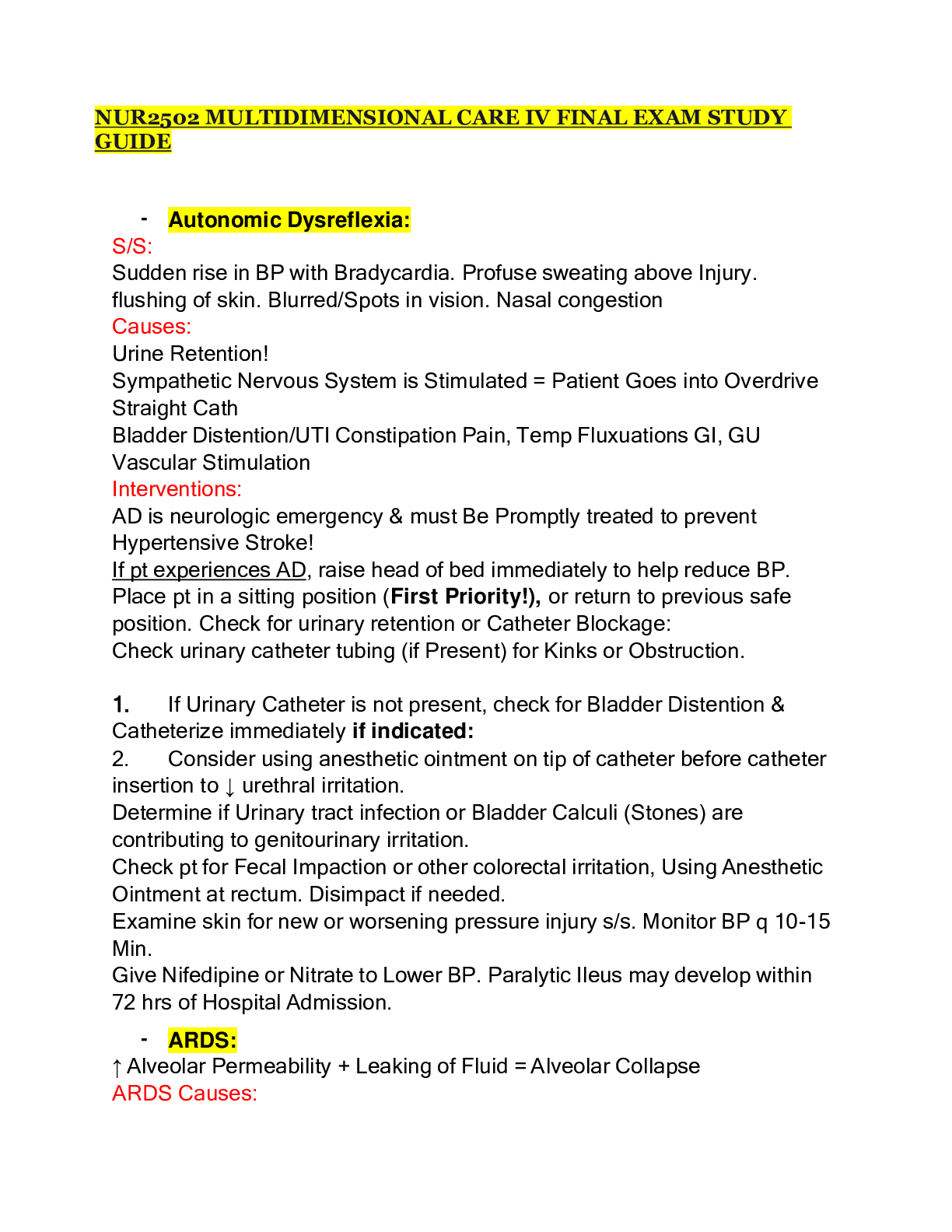
Buy this document to get the full access instantly
Instant Download Access after purchase
Buy NowInstant download
We Accept:

Reviews( 0 )
$15.00
Can't find what you want? Try our AI powered Search
Document information
Connected school, study & course
About the document
Uploaded On
Feb 04, 2022
Number of pages
20
Written in
Additional information
This document has been written for:
Uploaded
Feb 04, 2022
Downloads
0
Views
82


